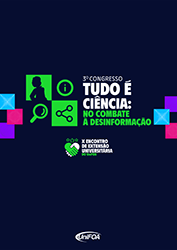Hipotensão pós exercício aeróbio agudo em homens
DOI:
https://doi.org/10.47385/tudoeciencia.1780.2024Palavras-chave:
Exercícios físicos. Pressão sanguínea. Saúde do indivíduo.Resumo
Objetivo: Investigar efeito de uma sessão isolada de caminhada, nas variáveis pressão arterial sistólica (PAS), pressão arterial diastólica (PAD) e frequência cardíaca (FC). Metodologia: Estudo em andamento. Amostra: homens (n = 8), idade 41,4 ± 5,7. Todos em uso de medicação para controle da PA com supervisão médica (PA média em repouso: 131,4 ±4,2 mmHg), colaboradores, docentes e discentes do Centro Universitário de Volta Redonda (UniFOA), aceitaram participar e assinaram termo de consentimento livre e esclarecido (TCLE). Resultados: Todos completaram 18 minutos de caminhada. Velocidade média da esteira: 4,4 ± 0,9 mph. Nível de percepção subjetiva de esforço registrado entre ‘0’ = Nenhum esforço a até ‘3’ = Moderado para 82,3% dos participantes e, 17,7% destes, classificaram ‘4’ Pouco Cansativo. A intensidade, calculada pela média de FC em relação à FC_máxima foi: 40,0% durante o repouso, 48,6% após 18 minutos de caminhada e 48,6% após 30 minutos de recuperação. Resposta da PAS no baseline, média: 131,4±4,2 mmHg. Após 18 minutos de caminhada: 138,3 ± 18,4 mmHg, e após 30 minutos de recuperação: 123,8 ± 3,5 mmHg. Na PAD, durante repouso, média: 80,6±9,9 mmHg. Após 18 minutos de caminhada: 82,5 ± 12,7 mmHg e após 30 minutos de recuperação: 82,4±10,6 mmHg. Conclusão: Exercício de baixa ou moderada intensidade, pode ser boa opção nas ações de gerenciamento da PA, em hipertensos, com devido acompanhamento médico e associada à ação do Profissional de Educação Física.
Downloads
Referências
ANDRADE C. Physical Exercise and Health, 2: Benefits Associated With Different Levels and Patterns of Activity. J Clin Psychiatry. 2023;84(5):23f15110. doi:10.4088/JCP.23f15110. 2023
ANUNCIAÇÃO PG et al. Blood pressure and autonomic responses following isolated and combined aerobic and resistance exercise in hypertensive older women. Clin Exp Hypertens; 38(8): 710-714. 2016
BARROSO, W K S et al. Brazilian Guidelines of Hypertension Arq Bras Cardiol 116(3): 516-658. 2021
BRASIL IA et al. Central and peripheral mechanisms underlying postexercise hypotension: a scoping review. J Hypertens 42(5): 751-763).2024
BRUNEAU, M. L et al.The blood pressure response to acute and chronic aerobic exercise: A meta-analysis of candidate gene association studies J Sci Med Sport. 19(5): 424-431.2016
CARVALHO T et al. Brazilian Guideline for Exercise Test in the Adult Population - 2024. Diretriz Brasileira de Ergometria em População Adulta – 2024. Arq Bras Cardiol;121(3):e20240110. 2024. doi:10.36660/abc.20240110
DIAO X et al. Physical activity and cancer risk: a dose-response analysis for the Global Burden of Disease Study 2019. Cancer Commun (Lond). 43(11):1229-1243. doi:10.1002/cac2.12488. 2023
HAMER M et al. The effect of acute aerobic exercise on stress related blood pressure responses: a systematic review and meta-analysis. Biol Psychol. 71(2): 183-190. 2006
HALLIWILL JR et al. Alpha-adrenergic vascular responsiveness during postexercise hypotension in humans. J Physiol. 550(Pt 1): 279-286; 2003.
KARVONEN MJ et al. The effects of training on heart rate; a longitudinal study. Ann Med Exp Biol Fenn. 35(3):307-15. 1957. PMID:13470504.
KOBAYASHI Y, et al. Strength training is more effective than aerobic exercise for improving glycaemic control and body composition in people with normal-weight type 2 diabetes: a randomised controlled trial [published correction appears in Diabetologia. 2024 Aug;67(8):1725-1726. doi: 10.1007/s00125-024-06135-2]. Diabetologia. 2023;66(10):1897-1907. doi:10.1007/s00125-023-05958-9
LIGUORI, G et al (ed.). American College of Sports Medicine, author, issuing body. ACSM's guidelines for exercise testing and prescription. Philadelphia : Wolters Kluwer, USA. ISBN- 9781975150181 (spiral bound). 2022
MANCIA, G et al. ESH Guidelines for the management of arterial hypertension The Task Force for the management of arterial hypertension of the European Society of Hypertension Endorsed by the European Renal Association (ERA) and the International Society of Hypertension (ISH) J Hypertens 41:000–000 Copyright © 2023 Wolters Kluwer Health, Inc. All rights reserved. DOI:10.1097/HJH.0000000000003480
MACDONALD H et al. Effects of concurrent exercise on hypertension: Current consensus and emerging research. In: Effects of Exercise on Hypertension: From Cells to Physiological Systems, Pescatello L, (editor). New York: Humana Press. pp. 47–86. 2015
MCLEOD JC et al. The influence of resistance exercise training prescription variables on skeletal muscle mass, strength, and physical function in healthy adults: An umbrella review. J Sport Health Sci. 2024;13(1):47-60. doi:10.1016/j.jshs.2023.06.005
PEREZ, A. J. Treinamento corporal humano - fundamentos para a prática de exercícios e de esportes. Curitiba/PR: Appris, 2018.
PESCATELLO LS et al. Assessing the Existing Professional Exercise Recommendations for Hypertension: A Review and Recommendations for Future Research Priorities. Mayo Clin Proc. 90(6): 801-812. 2015
PESCATELLO LS et al. Do the combined blood pressure effects of exercise and antihypertensive medications add up to the sum of their parts? A systematic meta-review. BMJ Open Sport Exerc Med. 7(1):e000895. Published 2021 Jan 20. doi:10.1136/bmjsem-2020-000895. 2021
WORLD HEALTH ORGANIZATION. Noncommunicable diseases country profiles 2018. Geneva: World Health Organization; 2018. Licence: CC BY-NC-SA 3.0 IGO. Geneva, World Health Organization. 2018
WORLD HEALTH ORGANIZATION. Hypertension indicators for improving quality and coverage of services, virtual meeting, 1–2 March 2021: report. Geneva, World Health Organization. 2021
ZHOU, B. et al. Global epidemiology, health burden and effective interventions for elevated blood pressure and hypertension. Nat Rev Cardiol 18(11): 785-802. 2021
ZHANG M et al. Effects of exercise interventions on cognitive functions in healthy populations: A systematic review and meta-analysis. Ageing Res Rev., 92:102116. doi:10.1016/j.arr.2023.102116. 2023
Downloads
Publicado
Como Citar
Edição
Seção
Licença
Copyright (c) 2025 Tudo é Ciência: Congresso Brasileiro de Ciências e Saberes Multidisciplinares

Este trabalho está licenciado sob uma licença Creative Commons Attribution-NonCommercial-ShareAlike 4.0 International License.


